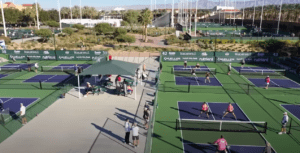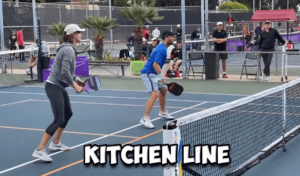
Are you interested in playing racquet sports but not sure whether to choose pickleball or tennis? While both sports involve hitting a ball over a net with a racquet, there are significant differences between the two, especially when it comes to the size of the court. Pickleball and tennis courts differ in size, net height, balls, paddles vs racquets, scoring, and serving.
One of the most obvious differences between pickleball and tennis courts is the size. A standard tennis court is 78 feet long and 36 feet wide, while a pickleball court is only 44 feet long and 20 feet wide. This means that you can fit four pickleball courts inside one tennis court! The smaller size of a pickleball court means that the game is played closer to the net, making it easier for beginners to cover the court and return shots.
Another key difference between the two sports is the net height. A tennis net is 3 feet high at the center, while a pickleball net is only 36 inches high at the center. The lower net height in pickleball makes it easier to hit overhead shots and encourages players to play more at the net. Additionally, the balls used in each sport are different. While tennis balls offer a heftier, more elevated bounce, pickleballs are designed to be smaller, lighter, and bounce lower.
Fundamentals of Pickleball and Tennis Court

Origin and Popularity
Pickleball and tennis are two racket sports that have gained immense popularity across the world. Tennis originated in England in the late 19th century, while pickleball was invented in the United States in the 1960s.
Tennis has been played professionally for many years and is one of the most popular sports in the world. It is played in both singles and doubles formats and is known for its fast-paced and intense gameplay.
On the other hand, pickleball is a relatively new sport that has gained a lot of popularity in recent years. It is played on a smaller court than tennis and is known for being a more accessible and beginner-friendly sport.
Court Dimensions

The dimensions of a pickleball court are smaller than those of a tennis court. A pickleball court measures 20 feet wide and 44 feet long, while a tennis court measures 27 feet wide and 78 feet long.
The net height is also different between the two sports. In pickleball, the net is 36 inches high at the sidelines and 34 inches high at the center. In tennis, the net is 3 feet high at the center and 3.5 feet high at the posts.
Another key difference between the two sports is the non-volley zone, also known as the “kitchen.” In pickleball, the non-volley zone is seven feet from the net on either side. In tennis, there is no non-volley zone.
Overall, while both pickleball and tennis are racket sports, they have distinct differences in court dimensions and gameplay. Be it tennis with its dynamic vigor or pickleball with its approachable nature, both sports present special and invigorating prospects for players at any level.
Surface Material Differences
When it comes to surface material, pickleball and tennis courts are quite different. Tennis courts are typically made of either clay, grass, or hard court materials such as asphalt or concrete. These surfaces provide a variety of textures and speeds, but they can be quite hard on the joints and can cause injuries if not maintained properly.
Pickleball courts, on the other hand, are typically made of a softer material such as cushioned tiles or acrylic surfaces. These surfaces are designed to be more forgiving on the joints and can help prevent injuries. They also provide a more consistent playing surface, which can be beneficial for players of all skill levels.
One important thing to note is that the surface material can affect the speed and bounce of the ball. In general, softer surfaces will slow down the ball and provide less bounce, while harder surfaces will speed up the ball and provide more bounce. This can have a significant impact on the game and can affect the strategies that players use.
Overall, the surface material differences between pickleball and tennis courts are significant and can have a big impact on the game. Whether you prefer the soft, forgiving surface of a pickleball court or the variety and challenge of a tennis court, it’s important to choose the right surface for your needs and skill level.
Line Markings Comparison
When it comes to line markings, there are some key differences between pickleball and tennis courts. Here is a breakdown of the most important differences:
- Court Size: A regulation pickleball court measures 20 feet wide by 44 feet long, while a tennis court measures 60 feet wide by 120 feet long. This means that a tennis court is three times larger than a pickleball court.
- Service Line: In tennis, the service line is located 21 feet from the net, while in pickleball, the service line is located 15 feet from the net. This means that pickleball players have less distance to cover when returning a serve.
- Baseline: The baseline in tennis is located at the back of the court, while in pickleball, it is located 22 feet from the net. This means that pickleball players have less space behind them when trying to hit a deep shot.
- Sideline: The sideline in tennis is located at the edge of the court, while in pickleball, it is located 7 feet from the net. This means that pickleball players have less space to hit a wide shot.
- Non-Volley Zone: In pickleball, there is a non-volley zone (also known as the kitchen) that extends 7 feet from the net on either side of the court. Players are not allowed to hit the ball while standing in this zone, except if the ball bounces in the zone first. There is no equivalent in tennis.
- Center Line: In pickleball, there is a center line that divides the court into two halves. This line is only used during serve and must not be crossed until the ball is hit. There is no equivalent in tennis.
Understanding the differences in line markings between pickleball and tennis courts is essential for players who want to switch between the two sports. While there are some similarities, there are also some significant differences that can affect gameplay. Make sure you are familiar with the line markings before you step onto the court.
Net Height and Position
One of the key differences between a pickleball court and a tennis court is the net height. The net height in pickleball is 36 inches (0.914 meters) at the center and 34 inches (0.86 meters) at the edges. In contrast, the net height in tennis is 42 inches (1.07 meters) at the posts and 36 inches (0.914 meters) at the center. The difference in net height can affect the game in various ways.
In pickleball, the lower net height allows for more aggressive play at the net. Players can hit the ball downward with greater force and accuracy, making it harder for their opponents to return the ball. The lower net height also means that players have less time to react to the ball, making the game faster-paced and more exciting.
In tennis, the higher net height makes it more difficult to hit the ball downward with force. Players must use more topspin to keep the ball in play, which can slow down the game. The higher net height also means that players have more time to react to the ball, which can lead to longer rallies.
The net position is also different between pickleball and tennis. In pickleball, the net is positioned in the center of the court, dividing the court into two equal halves. In tennis, the net is positioned slightly closer to the baseline on one side of the court, creating a larger area on one side of the court known as the “deuce court.”
Overall, the differences in net height and position between pickleball and tennis can significantly impact the game. Whether you prefer the fast-paced action of pickleball or the strategic gameplay of tennis, both sports offer unique challenges and rewards for players of all skill levels.
Serving Areas
One of the main differences between pickleball and tennis courts is the serving areas. In tennis, the service area is located behind the baseline and is 21 feet wide. The server can serve from anywhere within this area.
In pickleball, the serving area is much smaller. The server must stand behind the baseline and serve the ball diagonally into the opposite service court. The serving area is only 7 feet wide and extends from the centerline to the sideline. This means that the server must be very precise with their serve, as they have a much smaller area to aim for.
Another difference between the serving areas in pickleball and tennis is the way the ball is served. In tennis, the ball is served overhand and the server can hit the ball with a lot of power. In pickleball, the ball must be served underhand and the server must use a more controlled motion.
It’s important to note that in pickleball, the serving team only gets one serve. If the ball hits the net and lands in the correct service court, the serve is considered good and play continues. If the serve is out of bounds or hits the net and doesn’t land in the correct service court, the serving team loses their serve and the opposing team gets a chance to serve.
Overall, the serving areas in pickleball and tennis are quite different. Pickleball has a smaller serving area and requires a more controlled serve, while tennis has a larger serving area and allows for more powerful serves.
Scoring Zones
In both pickleball and tennis, there are specific areas on the court where points can be scored. However, the scoring zones differ between the two sports.
In pickleball, the scoring zones are the kitchen and the court boundaries. The kitchen, also known as the non-volley zone, is a 14-foot area on either side of the net where players cannot hit the ball in the air. This zone is designed to prevent players from smashing the ball directly over the net and winning points too easily. If a player hits the ball in the kitchen, the point is awarded to the other team. The court boundaries are marked by lines and any ball that lands outside these lines is considered out of bounds and results in a point for the opposing team.
In tennis, the scoring zones are the service box and the court boundaries. The service box is a rectangular area on either side of the net where the server must hit the ball to start the point. If the ball lands outside the service box, the server loses the point. The court boundaries are also marked by lines and any ball that lands outside these lines is considered out of bounds and results in a point for the opposing team.
It’s worth noting that in both sports, the ball must land within the boundaries of the court before bouncing for the point to be valid. If the ball lands outside the court boundaries before bouncing, the point is awarded to the opposing team.
Understanding the scoring zones is crucial in both pickleball and tennis, as it can help players strategically place their shots and win points.
Player Positioning
When it comes to player positioning, there are some key differences between pickleball and tennis. In pickleball, players are typically closer to the net than in tennis, which means that they need to be quick on their feet and ready to react to fast-paced shots. In tennis, players tend to stand further back from the net, which gives them more time to react to shots and make strategic plays.
In pickleball, the server is required to stand behind the baseline and serve diagonally to the opposite service court. After the serve, the server is expected to move forward to the non-volley zone, also known as the kitchen, which is the area closest to the net. The other player or players must stand behind the baseline until the ball is served. Once the ball is served, players can move freely around the court.
In tennis, the server is also required to stand behind the baseline, but they can serve to any part of the opposite service court. The other player or players must stand behind the baseline until the ball is served, but they are free to move around the court at any time.
In both sports, players must be aware of their position on the court and be ready to move quickly to cover the court and make strategic plays. However, because pickleball courts are smaller than tennis courts, players in pickleball need to be even more aware of their positioning and be ready to react quickly to shots that are hit close to the net.
Overall, player positioning is an important aspect of both pickleball and tennis, but there are some key differences between the two sports. Whether you’re a seasoned player or just starting out, it’s important to understand the rules and strategies of each sport to be successful on the court.
Conclusion
Now that you have learned about the differences between pickleball and tennis courts, you can make an informed decision about which sport to play and which court to use. Here are some key takeaways:
- Pickleball courts are smaller than tennis courts, making them easier to set up and use in smaller spaces.
- Pickleball uses a different type of ball that is lighter and has less bounce than a tennis ball, making it easier to hit and control.
- Pickleball is generally considered to be a more social and less competitive sport than tennis, although both sports can be played at any level of intensity.
- Tennis courts can be used for pickleball, but pickleball courts cannot be used for tennis due to their smaller size.
Overall, both pickleball and tennis are great sports that offer a fun way to stay active and socialize with others. Whether you prefer the fast-paced action of tennis or the more relaxed atmosphere of pickleball, there is a court and a community out there for you. So grab your racket or paddle and get out there and play!

